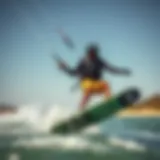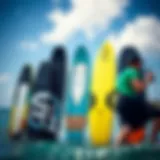The Importance of Impact Vests in Kiteboarding
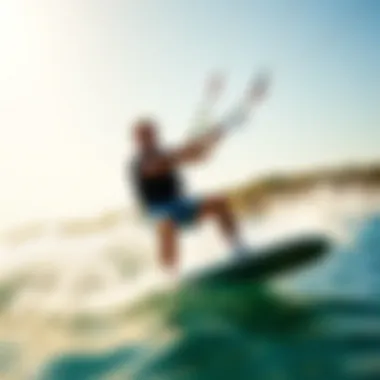
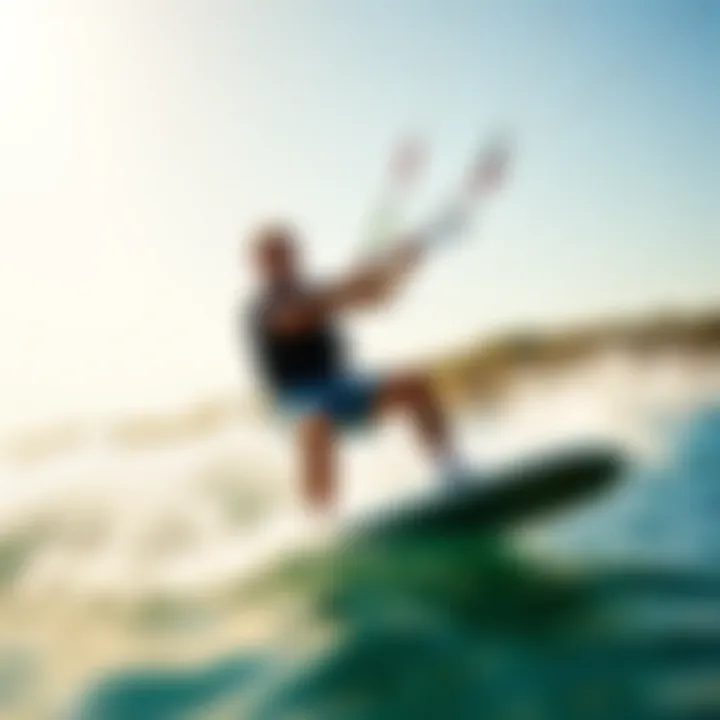
Intro
Kiteboarding is not just an adrenaline-fueled sport; it’s a dance between rider, wind, and water. Yet, amid the thrill and excitement, safety cannot take a back seat. This is where impact vests come into the picture, standing as a frontline defense for kiteboarders. An impact vest isn’t merely a safety accessory; it’s an essential piece of gear that can significantly influence a rider’s performance and confidence.
In this article, we will take a closer look at the role of impact vests in kiteboarding. We will explore not just their critical safety features but also the advances in technology and design that have made them indispensable for both beginners and seasoned riders. We’ll discuss how to choose the right vest, dive into specifics of maintenance, and compare leading brands. Furthermore, we will reflect on the trends shaping the future of impact vests in kiteboarding—a sport that continues to evolve with the wind.
Gear Insights
A kiteboarder’s gear is everything. The wind can be unpredictable, the waters restless, and the excitement palpable. Having the right equipment makes all the difference. Let’s delve into the latest gear reviews and essential gear for beginners to ensure a safe and enjoyable experience.
Latest Gear Reviews
When choosing an impact vest, it’s crucial to stay informed about the latest offerings in the market. Innovations abound, and brands are upping their game constantly. A few notable examples include:
- Mystic Brand Impact Vest: Known for its flexibility, this vest uses lightweight materials that enhance comfort without compromising safety.
- ION KITE Impact Vest: It integrates lumbar support while providing excellent impact protection. The design minimizes chafing, catering to all-day riders.
- Cabrinha Impact Vest: This one features a sleek design with strategically placed padding. Its construction allows for full range of motion while ensuring safety against jolts and falls.
Each of these vests has unique features, and it’s essential to find one that matches your riding style and comfort level.
Essential Gear for Beginners
For those dipping their toes into kiteboarding, selecting the right gear can feel overwhelming. Along with a good impact vest, beginners should consider:
- Kite: Start with a beginner-friendly kite, usually medium-sized, to keep control during learning.
- Board: A wider and larger board offers better stability for novice riders.
- Harness: Choose between waist and seat harnesses; comfort is key here.
- Safety Leash: This is vital to detach from the kite in emergencies, preventing dangerous situations.
- Helmet: Protecting your head is non-negotiable.
These essentials will lay a strong foundation for a rewarding kiteboarding journey.
Techniques and Tips
Success in kiteboarding goes beyond having the right gear; finesse in techniques and a strong grasp of safety practices hold immense value.
Advanced Tricks and Techniques
Once you’ve mastered the basics, it’s time to kick it up a notch. Advanced maneuvers like jumps, spins, and flips are rewarding but require practice and patience. Remember:
- Always maintain proper body positioning during tricks to avoid falls.
- Practice each move on land before committing to the water.
- Don’t hesitate to watch tutorials or join workshops for hands-on guidance.
Safety Practices for Kiteboarders
Every kiteboarder should keep safety at the forefront. Here are some established practices that can significantly minimize risks:
- Check Wind Conditions: Always assess the wind pattern and speed before hitting the water. Strong gusts can be challenging, especially for beginners.
- Pre-use Equipment Inspection: Inspect your gear beforehand. Ensure everything is in working order, and don’t skip that checklist.
- Buddy System: Kite with a friend. Not only is it more fun, but having someone close can make a difference in emergencies.
"Kiteboarding is 90% skill and 10% safety equipment."
Always put in the efforts to master the basics, but also respect the protective measures that keep you safe.
Prelims to Impact Vests in Kiteboarding
When kiteboarding hits the scene, safety takes center stage. One of the pivotal components in ensuring rider safety and boosting performance is the impact vest. Understanding their significance isn’t just for the enthusiasts but is fundamental for anyone stepping onto the water with a kite and board.
Impact vests serve more than a decorative purpose; they play a vital role in cushioning the blow from unexpected falls or crashes, which are unfortunately part and parcel of the sport. Unlike traditional life jackets, these specially designed vests offer both protection and freedom of movement, allowing riders to perform at their peak while minimizing risk. In essence, they are a bridge between safety and performance, offering riders the confidence to push their limits.
Understanding Impact Vests
Impact vests are constructed with high-density foam and specialized materials that absorb impact. When you’re smashing into the water at high speeds or landing a jump, having that added layer of cushioning can make a world of difference. A quality vest spreads the force of an impact over a larger area, reducing the chances of injury. But it isn’t all about impact protection. Riders need to consider how these vests fit and feel during their sessions.
Many modern impact vests are tailored to contour the body, providing a second-skin feel, and allow for optimal mobility. This balance ensures that while you are shielded from harm, you don’t feel like you’re lugging around extra weight. Additionally, ventilation features in many designs help in maintaining comfort during warm weather, which is vital when you're sweating it out under the sun.
Importance of Safety Gear
Safety gear in kiteboarding is not just a personal choice; it’s practically a lifeline.
- Minimized Risk of Injury: Venturing into kiteboarding without proper gear increases the likelihood of injuries, from bruises to more serious injuries like concussions. Wearing an impact vest can reduce the severity of these injuries.
- Confidence Boost: Knowing that a protective vest is on can help riders push their limits, whether they are attempting a complex trick or just going for an exhilarating ride. This added confidence can lead to improved performance and a more enjoyable experience overall.
- Community Standards: In many kiteboarding circles, safety gear has become the norm rather than the exception. As riders exchange experiences, recommendations, and tips, wearing an impact vest signals a commitment to safe practices on the water.
"When I first started kiteboarding, I thought safety gear was for beginners. Now, I can't imagine hitting the water without my vest. It just gives me peace of mind to push my limits!" - A seasoned kiteboarder.
Key Design Features of Impact Vests
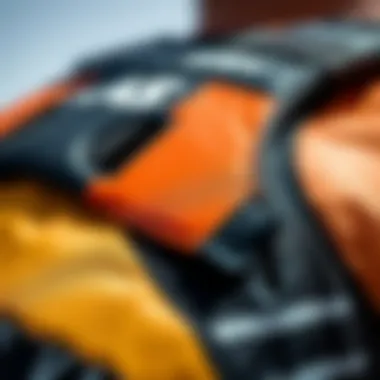
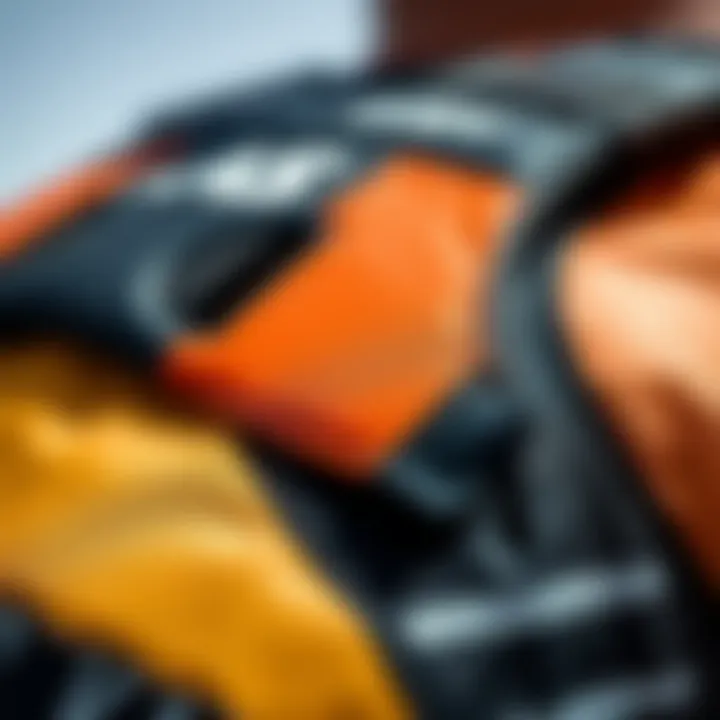
When it comes to kiteboarding, the right impact vest can make a world of difference. It’s not just about looking good on the water; the design features of these vests directly influence safety and performance. Let’s break down the key elements that distinguish quality vests from the less effective choices.
Material Composition
The materials utilized in impact vests play a crucial role in their effectiveness. Modern vests are crafted from a blend of high-strength fabrics that offer both durability and flexibility. Common materials include neoprene and high-density polyethylene, each bringing unique advantages. Neoprene, for instance, provides excellent insulation and stretches with the body’s movements, while high-density polyethylene offers superior impact resistance.
However, choosing materials isn’t just about strength. The breathability of the fabric matters too. Riders often experience high levels of exertion, and vests made from breathable materials keep the user comfortable by allowing moisture to escape.
- Benefits:
- Enhanced protection against impacts.
- Greater freedom of movement.
- Comfort during extended sessions on the water.
Fit and Comfort
A vest that doesn’t fit right can hinder performance and even cause discomfort during a session. The cut of the vest should allow for a snug fit without being restrictive. That is to say, riders should be able to reach, twist, and maneuver without feeling constricted. Look for vests with adjustable straps or zipper systems which can help provide a better fit.
Comfort is often an overlooked aspect. A poorly designed vest can rub against the skin or create pressure points, leading to irritation. The interior lining should be soft and smooth, ensuring that wearers can focus solely on their ride. When testing a vest, it’s vital to assess not just how it looks but how it feels during movements.
Buoyancy and Floatation
While impact protection is the primary goal, buoyancy shouldn’t take a backseat. An effective impact vest needs to balance safety with flotation capabilities. Vests often integrate floating materials designed to assist riders in staying above water, which can be crucial in emergencies. This feature significantly enhances safety, making it easier to stay afloat and reducing fatigue during longer rides.
However, the amount of buoyancy should not compromise mobility. Riders should avoid overly buoyant vests that hinder movement and agility. A well-designed vest strikes this balance, allowing swift maneuvers essential for kiteboarding.
In summary, these design features—material composition, fit and comfort, and buoyancy—are the backbone of any quality impact vest. Choosing the right one goes beyond aesthetics; it’s about ensuring safety and performance on the water. Getting a grasp on these aspects will empower riders to make informed decisions, ultimately enhancing their kiteboarding experience.
Impact Vests and Rider Performance
Impact vests serve a pivotal role in kiteboarding, offering riders not just protection but also enhancing overall performance. Safety gear, when thoughtfully designed, can become an extension of the rider's body, allowing them to push their limits while maintaining a sense of security. Understanding how impact vests influence rider performance entails looking into two primary aspects: confidence on the water and injury prevention techniques.
Enhancing Confidence on the Water
The psychological effect of wearing an impact vest should not be brushed aside. The moment a kiteboarder straps on a well-fitted impact vest, something shifts—not just in their gear, but in their mindset. It’s like having an invisible shield. When riders know they have that extra layer of protection, they often take bolder risks and explore maneuvers they might’ve otherwise hesitated to attempt.
Consider the difference between riding with just a standard wetsuit versus donning an impact vest. The vest not only provides essential buoyancy but offers a layer of padding that can help soften falls. Knowing that their body is safeguarded emboldens riders to venture into uncharted territory, boosting their overall skill level. Many riders remark that their confidence soars, transforming the experience on the water from pure anxiety over potential mishaps to an exhilarating sense of freedom.
It's worth noting that this confidence contributes to better focus. From seasoned professionals to novices, when riders are not preoccupied with thoughts of injury, they can concentrate more on improving their technique and enjoying the ride. That's when creativity in riding really flourishes.
Injury Prevention Techniques
Injury prevention is undeniably the foremost function of an impact vest. Kiteboarding, while thrilling, carries the risk of various physical hazards—collisions with the board, falls from heights, or even encounters with the beach. An impact vest is ingeniously designed to mitigate these risks through smart material use and structural design.
For instance:
- Foam Liners: Many impact vests integrate high-density foam that absorbs shocks and decreases the risk of injury from falls.
- Segmented Panels: The design often includes segmented or flexible panels that adapt to the body's movements, providing protection without restricting agility.
- Impact-Resistant Materials: Innovators are continually researching and implementing materials that disperse energy during impact, reducing the blunt force trauma that riders might experience.
But it’s more than just about cushioned falls. A vest can also play a role in preventing injuries from repetitive strain. The support provided can help maintain proper posture and core stability during rigorous activities, reducing the chances of long-term ailments, especially in the lower back and ribs. Creating an optimal riding position can mean the difference between merely hanging on and mastering a routine with grace.
"The right gear makes you feel invincible on the water, which is key for pushing boundaries in kiteboarding."
Ultimately, understanding the balance between safety and performance is crucial for every kiteboarder. The right impact vest does not merely protect but enhances the entire riding experience, setting the stage for personal growth and skill advancement in this exhilarating sport.
Innovations in Impact Vest Technology
In the world of kiteboarding, safety and performance go hand in hand, and the innovations in impact vest technology are at the forefront of this intersection. As kiteboarding evolves, so does the technology that supports it, leading to enhanced safety and a better experience on the water. New materials and techniques are not only designed to absorb impact but also improve the rider's performance and comfort.
Adaptive Materials
Adaptive materials in impact vests have changed the game for kiteboarders. These are specialized fabrics that respond to the conditions they encounter. For instance, certain vests utilize memory foam-like materials that contour to the body, offering a bespoke fit while still being lightweight. When a rider takes a hit from a fall, the material hardens on impact, dispersing the energy and reducing injury risk. This is particularly crucial given the dynamic nature of kiteboarding, where sudden shifts in wind or unexpected tumbles are par for the course.
Additionally, moisture-wicking fabrics are increasingly used to keep kiteboarders dry and comfortable. Having a vest that can excel in both protecting and keeping the body at a moderate temperature is paramount. High-performance fabrics, like those made with advanced polymers, allow for better breathability and thermal regulation. They provide the necessary buoyancy while ensuring that the rider isn’t bogged down by heavy, soggy gear. As kiteboarding pushes the limits of performance, so too do these materials push the boundaries of comfort and adaptability.
Integrated Safety Systems
The evolution of integrated safety systems in impact vests marks a notable shift towards a more holistic approach to rider safety. These innovations encompass features such as built-in emergency signal systems and various safety mechanisms designed to work seamlessly with kiteboarding gear. For example, vests with integrated flotation devices ensure riders remain afloat in harsh conditions, while also reducing the risk of drowning if they’re knocked unconscious during a fall.
Moreover, some advanced designs link directly to rider harnesses, offering additional stability and connection without compromising mobility. This integration allows kiteboarders to navigate various conditions with a greater sense of security, as they can focus on their performance instead of worrying about their safety gear failing in a critical moment.
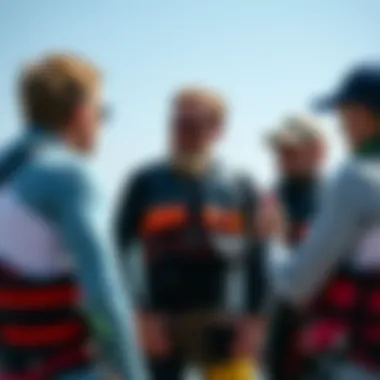

"Impact vests with integrated safety systems provide kiteboarders something priceless: peace of mind."
Furthermore, many brands are now embedding technology that interfaces with smartphones to enhance safety awareness. These systems can provide valuable data on wind conditions and rider location, serving not only as a guide but as a vital instrument in emergency situations. It’s becoming increasingly clear that innovations in impact vest technology are not just about protecting riders; they’re about enhancing the entire kiteboarding experience.
Choosing the Right Impact Vest
Selecting the appropriate impact vest for kiteboarding is a pivotal decision that can influence not only your safety but also your overall experience on the water. With so many options buzzing around, it's essential to navigate this decision with care. The right vest doesn't just safeguard; it enhances your performance by allowing you to focus on your skills rather than fretting over potential injuries.
When choosing, consider several factors that contribute to both comfort and utility. A vest that fits well will not only protect you effectively but will also allow unrestricted movement, letting you catch the wind and surf the waves with ease.
Factors to Consider
- Fit: A snug but not too tight fit is ideal. Too loose, and it could shift during your ride; too tight, and it restricts your movements.
- Material: Look for durable yet lightweight materials such as neoprene or specialized foams. These materials not only offer protection but also enhance buoyancy.
- Flexibility: Vests designed with flexible segments or panels allow for greater mobility. You're going to want to be able to twist and turn without feeling like you're in a straitjacket.
- Buoyancy: Depending on your riding style and the conditions, a vest with decent buoyancy can make a world of difference. It helps keep you afloat in rough waters.
- Additional Features: Some vests come with pockets for storage and further protection layers. Having some handy features can boost your kiteboarding experience.
- Design and Style: While not the main concern, it’s indeed nice to feel good while you ride. A design that resonates with your personality can add to your confidence.
Recommended Brands and Models
When it comes to names you can trust, certain brands have secured a solid footing in the kiteboarding community. Here’s a look at some vests that stand out for their quality and performance:
- Mystic Warrior Vest: Known for its excellent fit and flexible materials, the Mystic Warrior provides great protection without feeling cumbersome.
- Ion Strike Vest: Packed with features, Ion’s vest blends buoyancy and mobility perfectly, making it a popular choice among avid kiteboarders.
- O'Neill Psycho Vests: This model is praised for its flexibility and durability, ensuring that you stay protected without feeling limited.
- Prolimit Fly Vest: Lightweight yet robust, this vest is favored for those who prefer a sleek design that doesn't compromise safety.
"Choosing the right impact vest can mean the difference between riding with confidence and riding with fear. The right fit supports your performance while keeping you safe."
With these tips and recommendations, you are better poised to make an informed decision when it comes to your next impact vest. It’s an investment in your safety and enjoyment on the waves, so take your time and choose wisely.
Safeguarding Longevity: Care for Your Impact Vest
Caring for an impact vest goes beyond just maintaining its physical appearance; it’s essential to keep your gear in top shape to ensure maximum protection while kiteboarding. Proper care extends the lifespan of your vest, allowing you to enjoy countless sessions on the water without worrying about your safety equipment failing you. Without regular maintenance, even the best impact vest can suffer degradation over time, which is something no rider wants to face when launching into the waves.
Maintenance Guidelines
To ensure your impact vest remains in peak condition, adopt these maintenance practices:
- Rinse After Use: After a day on the water, always rinse your vest in fresh water. This simple yet crucial step helps remove salt, sand, and other impurities that may degrade the fabric and stitching.
- Inspect Regularly: Make it a habit to check your vest for any signs of wear and tear, such as frayed seams or damaged zippers. Discovering issues early can prevent safety hazards later on.
- Machine Wash with Care: If the manufacturer permits, you might consider washing your vest in a washing machine. However, always use a gentle cycle and cold water to avoid damaging the materials. Avoid fabric softeners as they can reduce buoyancy.
- Air Dry: After washing, never toss your vest in a dryer. Let it air dry in a shaded area, ensuring that it maintains its shape and doesn’t shrink.
- Avoid Excessive Sun Exposure: Prolonged exposure to direct sunlight can weaken the materials over time. If you're not using your vest, store it in a cool, dark place.
Taking these steps will greatly contribute to extending the life of your impact vest and ensuring your safety on the water.
Storage Practices
How you store your impact vest is just as important as how you maintain it. Follow these guidelines to keep your gear safe and functional:
- Hang It Up: Instead of folding your vest, hang it up using a hanger. This prevents creases and helps maintain its shape. A thick hanger is preferred as it won't distort the fabric.
- Keep It Dry: Store your vest in a dry environment. Moisture can lead to mold and mildew, which can be detrimental to the material and unhealthy.
- Avoid Tight Spaces: Don’t stuff your vest into small spaces where it might get crushed or cramped. Allow it to breathe and keep its structure intact.
- Check for Bugs: If you’re storing your vest for a long time, check periodically for any pests that may have found their way into your storage area. Bugs can sometimes hide in fabric, leading to unexpected damage.
- Use a Mesh Bag: If you want to take additional precautions, consider keeping your vest in a breathable mesh bag. This allows for air circulation, reducing moisture buildup.
By taking simple actions like these, you contribute not just to the longevity of your impact vest, but also to your overall safety when kiteboarding. Remember, a well-cared-for vest does wonders for your peace of mind out on the water.
Impact Vests in Relation to Other Safety Gear
When it comes to kiteboarding, safety gear is paramount for anyone who takes to the waves, whether you're a novice or an experienced rider. Impact vests are a critical component of this gear, serving unique functions that complement other safety equipment, such as helmets and impact shorts. Understanding these relationships not only enhances rider safety but also improves overall performance.
Comparative Analysis with Helmets
When you put a helmet on, you're shielding your head from the unknown unpredictability of crashes or fall — it's pretty straight forward. Helmets are designed to absorb shock and prevent head injuries. However, they don’t provide support for the torso or other vital areas of the body. That's where vests come into play.
Key Differences:
- Coverage Area: Helmets protect the head; impact vests act like an armor for the torso. Riders often take spills that lead to bruises, fractures, or even internal injuries.
- Comfort and Movement: A helmet is securely fastened, but it can sometimes feel cumbersome. Impact vests, on the other hand, can be engineered for flexibility, allowing riders to twist and turn without restriction.
- Weight Distribution: Helmets are concentrated weight on the head, which can lead to tension in the neck after prolonged use. Impact vests spread out impact over the torso, reducing localized pressure points.
This difference in focus alleviates concerns of injury while kiteboarding, thus marrying the two essential forms of safety gear into a well-rounded protective strategy. It’s about the interplay; a helmet is crucial, but without a vest, the rider is exposing themselves to unnecessary risks.
The Role of Impact Vests Versus Other Protective Wear
Impact vests don’t work in isolation; they partner with various other protective items, each contributing a unique layer of safety. Continuing from our earlier discussion, let's compare impact vests with other protective wear such as impact shorts and knee pads.
- Impact Shorts:
Impact shorts offer vital cushioning for the hips and tailbone, areas prone to injury during a rough fall. While impact vests cover the upper body, impact shorts minimize the risk of lower body injuries, creating a comprehensive safety blanket. - Knee Pads:
These focus solely on safeguarding the knees, which often bear the brunt during navigational mishaps. They complement the vest by ensuring that the joints are protected while the vest absorbs the shock of impacts on the chest and back. - Rash Guards:
These can be seen as 'first-layer' protection clothing against abrasions, but they do not offer substantial impact resistance. While they do help with sun protection and reduce chafing, they are no substitute for a well-constructed impact vest.
Ultimately, these safety items, including impact vests, create a synergistic effect. When combined properly, they fashion a formidable line of defense against the unpredictable nature of kiteboarding.
"The integration of various safety gear allows riders the liberation to explore the waves without the shadow of injury looming over them. Each piece serves its purpose, and when aligned well, they form a protective repertoire."
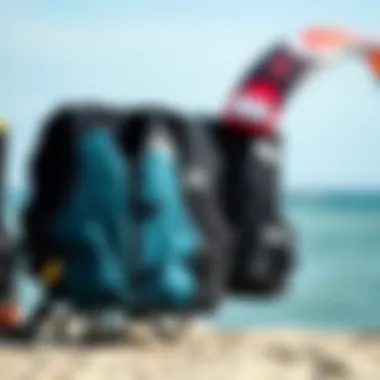
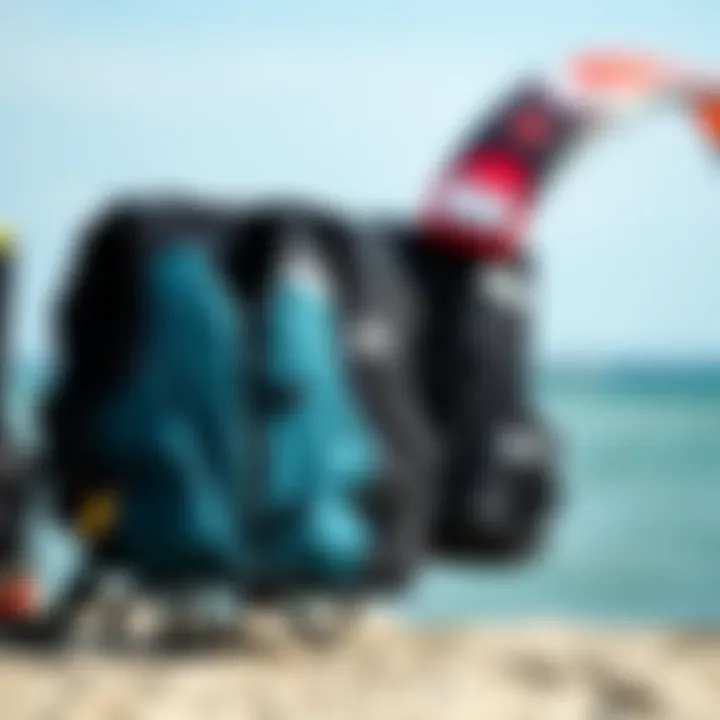
Community Perspectives on Impact Vests
Understanding the views of the kiteboarding community regarding impact vests offers valuable insights, revealing how these pieces of gear are perceived not only in terms of safety but also in their role in enhancing performance and fostering a culture of innovation. Exploring rider testimonials alongside insights from instructors and industry professionals helps to highlight the multifaceted nature of impact vests and their significance in kiteboarding.
Rider Testimonials
Riders often have firsthand experiences that speak volumes about the effectiveness and comfort of impact vests. Many enthusiasts share stories illustrating the immediate benefits they experience after donning an impact vest. For instance, one kiteboarder, Laura, recounts her encounter with the elements: "I took a hard fall while trying to perfect a new trick. What I thought was going to be a painful crash ended up being just a minor slip, thanks to my vest. It really gave me the confidence to push my limits."
Feedback like Laura's underscores a broader sentiment within the community. Riders emphasize their sense of security when wearing a vest, allowing them to focus on their performance rather than the fear of injury. Here are a few common themes from rider testimonials:
- Increased confidence: Riders consistently report feeling more assured in the water, leading to improved performance.
- Comfort and fit: Many vests are praised for their ergonomic designs, making them a joy to wear even during extended sessions.
- Durability and reliability: Users often highlight the longevity of high-quality vests, insisting that they remain effective over time.
These testimonials collectively paint a picture of how profound a positive impact vest can have on one’s kiteboarding experience.
Insights from Instructors and Professionals
Kiteboarding instructors and industry professionals also weigh in on the importance of impact vests within this sport. Their expertise provides a more analytical perspective, synthesizing user experiences with safety statistics and performance metrics. Instructors often encourage new riders to use impact vests, not just as a safety protocol, but as a necessary component of learning. Mark, an avid instructor, insists, "Starting with an impact vest can help beginner riders master their techniques without fear of injury, which is crucial to building their skills."
From the professional standpoint, the following considerations emerge:
- Safety teaching: Instructors advocate for the importance of wearing impact vests throughout the learning process and even beyond. Their goal is to foster a culture of safety amongst novice riders.
- Skill development: Professionals note that with an added layer of protection, students may be more likely to take on challenges they might otherwise shy away from. This leads to rapid skill enhancement.
- Technology adoption: Professionals are keen observers of advancements in vest design and materials, often sharing their findings with students to ensure their safety equipment is up to date.
These insights amplify the community discourse, making it clear that riding with an impact vest isn’t just advisable; it's essential for safety and personal growth in the sport.
Fostering dialogue around impact vests cultivates an atmosphere where safety standards are maximized, and rider performance continues to evolve. With testimonials from riders and affirmations from instructors, the kiteboarding community anchors its commitment to both safety and innovation, ensuring that every individual can enjoy their time on the water to the fullest.
Future Trends in Impact Vest Design
The evolution of impact vests in kiteboarding is an intriguing topic that merges safety with performance. As the kiteboarding community continues to grow and innovate, it’s essential to stay tuned in to future trends surrounding the design of impact vests. With advancements in technology, we can expect new features that not only protect riders but also enhance their experience on the water. Several key elements come into play when discussing these future trends.
Emerging Technologies
As technology leaps forward, the incorporation of smart materials and wearable technology into impact vests appears promising. For example, vests could one day be made from biomechanical fabrics that respond to impact, stiffening upon collision and providing better protection. Such a technology would potentially reduce injuries and enable riders to push their limits safely.
- Sensors: Imagine vests equipped with sensors that monitor heart rate, body temperature, and even hydration levels. These smart vests could seamlessly connect to a rider's phone or smartwatch, sending real-time updates. Such data could enhance performance insights during riding sessions, helping users make informed decisions.
- Data Integration: With the integration of augmented reality, riders could receive visual feedback about their performance through a connected device, possibly enhancing their skills or making adjustments on the fly.
These emerging technologies could significantly change how riders interact with their gear. As they become more aware of their physical conditions, safety becomes second nature rather than just an afterthought.
Sustainability Considerations
Another trend gaining traction is sustainability. As kiteboarding becomes more popular, there is a growing awareness of its environmental impact. Thus, the sustainability of materials used in making impact vests is now under the microscope. Companies are beginning to explore biodegradable materials and recycled fabrics to construct their gear.
- Eco-Friendly Materials: By using advanced techniques, brands can employ materials that reduce energy consumption and waste during the manufacturing process.
- Lifecycle Considerations: Manufacturers may also implement take-back programs, allowing consumers to return old vests for recycling, promoting a circular economy.
The movement toward sustainable gear reflects a broader shift in consumer values. Many riders are not just interested in safety but are also increasingly concerned about the ecological footprint of their purchases. The combination of sustainable practices and innovative materials might reshape the market for impact vests, appealing to environmentally conscious kiteboarders.
Finale: The Evolving Role of Impact Vests in Kiteboarding
The discussion around impact vests in kiteboarding reveals much about the current landscape of safety gear and performance tools in this thrilling sport. As kiteboarding continues to grow and evolve, the role of impact vests expands in ways riders, instructors, and gear manufacturers must adapt to. Unlike traditional safety gear, which merely focuses on protection, impact vests blend safety with a rider's performance needs, enabling kiteboarders to embrace the sport without compromising on safety or style.
One crucial aspect to underscore is that the design of impact vests has come a long way from the bulky, uncomfortable gear of previous decades. Modern vests are sleek, lightweight, and engineered with cutting-edge materials that cater to both comfort and functionality. This transformation allows riders to maintain agility while receiving vital protection against falls and impacts, thus aligning with the evolving demands of the sport.
The benefits of utilizing impact vests extend beyond mere protection. As riders gain confidence in their safety, they are more likely to push their limits, attempt new tricks, and ultimately enjoy a higher level of performance. This relationship between confidence and performance enhances the overall kiteboarding experience, fostering a culture where safety and adventure coexist harmoniously.
In addition, the innovations in impact vests mirror broader trends in sporting equipment that emphasize sustainability and adaptability. Many brands are now incorporating eco-friendly materials and designs, reflecting an awareness of environmental impacts. This shift not only appeals to environmentally conscious consumers but also sets a precedent for industry standards moving forward.
"Safety and innovation in kiteboarding gear are no longer mutually exclusive. Riding with confidence can now be embraced in tandem with responsible choices."
As we look to the horizon, the evolving role of impact vests suggests an exciting future ahead. Riders can anticipate even more advancements, such as smart technologies that monitor the wearer’s performance or enhanced buoyancy features tailored to diverse water conditions. Ultimately, the progress in impact vest design outlines a trajectory that emphasizes safety, performance, and a commitment to the environment—all critical for nurturing the kiteboarding community.
Summarizing Key Points
In summary, impact vests serve multiple critical roles in the kiteboarding realm. Here’s a concise breakdown:
- Safety: The primary purpose of an impact vest is to protect riders during falls, which can be frequent given the nature of the sport. The reduction in injuries directly correlates with the rider's willingness to take risks.
- Performance: Enhanced designs allow for comfort and agility, ensuring a seamless experience on the water, so riders can go all out without hesitation.
- Innovation: The drive for continual improvement leads to the adoption of new materials and technologies that enhance user experience, engaging the community in sustainability and effectiveness.
Implications for Future Practices
The future looks promising for impact vests and kiteboarding. The anticipated trends include:
- Integration of Smart Technology: Expect developments like sensors embedded in the vests that can provide data on a rider's health or performance metrics. This technology could reshape how riders train and interact with their gear.
- Environmental Responsibility: A push towards eco-friendly materials will not only reduce the environmental footprint but also appeal to a growing audience that values sustainability.
- Community Engagement: As riders become more informed, there is a push toward collaborative feedback loops with manufacturers, ensuring that the gear matches real-world user experiences.
In closing, as kiteboarding progresses, so must the gear that supports it. The evolving role of impact vests underscores a commitment to safety and performance, providing both peace of mind and enhanced experiences for kiteboarders worldwide.




